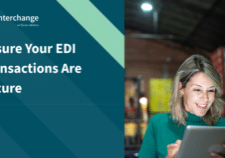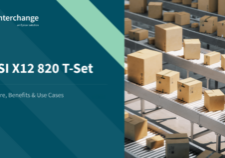The VDA 4938 Message: Structure, Benefits & Use Cases
Navigating the complexities of automotive supply chain communication is essential. And the VDA 4938 message plays a crucial role in this landscape.
As part of the broader VDA standards, it’s designed to facilitate seamless data exchange between partners, ensuring efficiency and clarity in transactions.
This guide will provide you with a comprehensive overview of the VDA 4938 message, unpacking its significance, application, and benefits. Whether you’re new to EDI standards or looking to deepen your understanding, this introduction will pave the way for leveraging VDA 4938 to enhance your business operations.
Suggested reading: Get up to speed on the overall standard with our guide to VDA.
What is the VDA 4938 message?
The VDA 4938 message plays a large role in communications within the automotive industry, serving as a cornerstone for enhancing operational efficiency and streamlining supply chain processes.
This message standard, developed under the German Association of the Automotive Industry (VDA), is tailored to meet the intricate demands of automotive manufacturers and their suppliers. The benefits and use cases of the VDA 4938 message span across various facets of automotive supply chain management, offering a robust solution for achieving seamless communication and operational synergy.
What are the benefits and use cases for the VDA 4938 message?
There are a number of benefits and applications associated with the VDA 4938 message that makes it well worth implementing into your B2B communications.
Benefits of the VDA 4938 message
- Standardisation across the automotive industry: Ensures a uniform format for communication, facilitating easier data exchange between partners.
- Efficiency in communication: Streamlines the exchange of information, reducing the time and effort needed for manual data entry and interpretation.
- Error reduction: Minimises the risk of errors in data transmission, leading to more accurate order processing and inventory management.
- Cost savings: Decreases administrative costs by automating the exchange of information, reducing the need for paper-based processes and manual intervention.
- Improved supply chain visibility: Enhances the ability to track and manage orders, shipments, and inventory levels in real time, improving overall supply chain efficiency.
- Enhanced partner integration: Facilitates easier integration with a wide range of business partners, regardless of their size or technological capability, promoting smoother collaboration.
Use cases for the VDA 4938 message
- Order management: Used for the electronic transmission of purchase orders, making the ordering process faster and more reliable.
- Delivery and shipment notifications: Enables the sending of advance shipping notices, helping recipients prepare for incoming goods and manage inventory more effectively.
- Invoice processing: Supports the electronic exchange of invoicing information, streamlining the billing and payment processes.
- Inventory management: Assists in the exchange of inventory reports and stock level updates, allowing for better inventory planning and control.
- Production planning and control: Facilitates the sharing of production schedules and demands, aiding in the synchronisation of supply chain activities.
- Quality data exchange: Allows for the transmission of quality-related documents and data, ensuring that products meet the required standards and specifications.
What’s the typical structure of a VDA 4938 message?
In order to fully understand the VDA 4938 message, it’s important to cover what it actually looks like and what its array of segments mean. Let’s first start with an example:
| UNA:+.? ‘UNB+UNOC:3+sender-id:14+recipient-id:14+030101:1234+00000000000778’UNH+1+INVOIC:D:01B:UN’BG M+380+20050105′ DTM+137:20050105:102′ NAD+BY+buyer-company::9′ NAD+SU+supplier-company::9′ CUX+2:EUR:9′ LIN+1++product-code:SA’ IMD+F++:::product-description’ QTY+47:100:PCE’ MOA+66:1500′ TAX+7+VAT+++:::19+S’ UNS+S’ MOA+79:1190′ UNT+13+1’UNZ+1+00000000000778′ |
And now let’s delve into the various segments of a VDA 4938 message and their purposes.
| Segment | Example | Description |
| Service String Advice (UNA) | “UNA:+.? ‘” | Specifies the special characters used in the message. |
| Interchange Header (UNB) | “UNB+UNOC:3+sender-id:14+recipient-id:14+030101:1234+00000000000778′” | Defines the start of the message, including sender and recipient information. |
| Message Header (UNH) | “UNH+1+INVOIC:D:01B:UN'” | Specifies the start of a message and its type (e.g., invoice). |
| Beginning of Message (BGM) | “BGM+380+20050105′” | Indicates the document type and its reference number. |
| Date/Time/Period (DTM) | “DTM+137:20050105:102′” | Specifies relevant dates and times for the message, like a document or effective date. |
| Name and Address (NAD) | “NAD+BY+buyer-company::9′” and “NAD+SU+supplier-company::9′” | Provides information on the buyer and seller involved. |
| Currencies (CUX) | “CUX+2:EUR:9′” | Specifies the currency used in the transaction. |
| Line Item (LIN) | “LIN+1++product-code:SA'” | Identifies a line item in the document. |
| Item Description (IMD) | “IMD+F++:::product-description'” | Provides a description of the item or service. |
| Quantity (QTY) | “QTY+47:100:PCE'” | Specifies the quantity of the item being referenced. |
| Monetary Amount (MOA) | “MOA+66:1500′” and “MOA+79:1190′” | Indicates various monetary amounts, such as line item amount and total invoice amount. |
| Duty/Tax/Fee Details (TAX) | “TAX+7+VAT+++:::19+S'” | Provides details on taxes applicable to the line item or total. |
| Section Control (UNS) | “UNS+S'” | Marks the beginning of the summary section of the message. |
| Message Trailer (UNT) | “UNT+13+1′” | Marks the end of the message, providing a count of the segments. |
| Interchange Trailer (UNZ) | “UNZ+1+00000000000778′” | Marks the end of the interchange, confirming the interchange control reference. |
How is a VDA 4938 message processed?
There are a number of steps involved in processing a VDA 4938 message, including the actual communication of the message as well as vetting its contents. These include:
- Data compilation: Relevant data is compiled from the sender’s internal systems for the message.
- Format conversion: The data is converted into the VDA 4938 format, adhering to specific structure and standards.
- Compliance check: The message undergoes a compliance check with the VDA 4938 standard to ensure all fields are correctly filled and formatted.
- Error detection: Any errors in the message are identified and corrected to prevent misunderstandings by the recipient.
- Secure sending: The message is sent to the recipient using a secure transmission method, such as EDI networks.
- Acknowledgment receipt: The sender receives an acknowledgment from the recipient’s system, confirming successful receipt.
- Initial processing: Upon receipt, the message undergoes initial processing to validate its structure and content.
- Error handling: Discrepancies or errors found are either automatically corrected or flagged for manual review.
- Extraction: Relevant data from the message is extracted for use in the recipient’s systems.
- Transformation: The extracted data may be transformed or reformatted to match the recipient’s internal data structures.
- Data analysis: The integrated data is analysed for actionable insights, such as inventory needs or production adjustments.
- Automated actions: The system may automatically initiate actions like order confirmations or inventory updates based on predefined rules.
- Record keeping: Both sender and recipient maintain records of the VDA 4938 message for future reference and compliance.
- Audit trail: A detailed log of all actions taken from message receipt to final processing is kept for traceability.
What are the equivalents of the VDA 4938 message in other standards?
Remember: the VDA standard likely won’t be the only EDI standard you’ll be dealing with. Here’s a breakdown of the equivalents of the message to other commonly used standards:
| EDI Standard | Equivalent of VDA 4938 |
| EDIFACT | INVOIC |
| ANSI X12 | 810 Invoice |
| Odette | ODETTE INVOICE |
| TRADACOMS | INVFIL |
| Peppol | Invoice |
Supercharge your EDI communications with Data Interchange
The VDA 4938 message, like its counterparts within the VDA standard, plays a pivotal role in streamlining automotive supply chain communications. This guide serves as a foundation for understanding its application and advantages.
The landscape of EDI standards, including various messages and transaction sets, is broad and essential for enhancing business communications and partnerships.
Partnering with an EDI managed support service like Data Interchange, boasting over 35 years of experience and a suite of EDI software solutions, can elevate your business’s EDI capabilities. For expert guidance on leveraging VDA 4938 and other EDI processes, reaching out to our specialists is your next step towards improved efficiency and partnerships.



























































































































